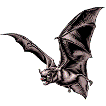Museum, University of Nebraska State

University of Nebraska State Museum: Mammalogy Papers
Document Type
Article
Date of this Version
2008
Citation
Journal of Mammalogy (2008) 89(5): 1,306-1,315.
Abstract
We phylogenetically analyze 705 base pairs of the cytochrome-b gene and 351 amplified fragment length polymorphism (AFLP) bands from populations of the karyotypically variable Wagner’s bonneted bat, Eumops glaucinus, and the Florida bonneted bat, Eumops floridanus (Chiroptera: Molossidae). Three karyotypes have been documented across the range of E. glaucinus, and we report that the karyotype from Cuba is morphologically similar to that from Jamaica. A 4th karyotype is present in specimens from western Ecuador. Three distinct lineages are present in both the cytochrome-b and AFLP trees. One lineage is restricted to western Ecuador and exhibits cytochrome-b divergence values comparable to the values seen between recognized species of Eumops, suggesting that this lineage represents a distinct species. The other 2 lineages are distributed in disjunct areas: Paraguay and Venezuela; and Mexico, the Caribbean, and the United States. Specimens of E. floridanus are morphologically distinct from E. glaucinus, but cannot be distinguished by examination of cytochrome-b or AFLP DNA data. We conclude that there are 4 species in the E. glaucinus complex— E. glaucinus (South America east of the Andes), E. ferox (Caribbean, Mexico, and Central America), E. floridanus in south Florida, and an unnamed taxon in western Ecuador. Speciation is a complex process and no single mechanism, model, concept, or definition is likely to cover all the diverse patterns observed.


Comments
Copyright 2008, American Society of Mammalogists. Used by permission.